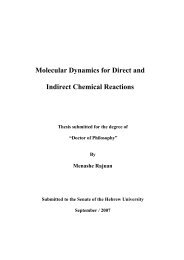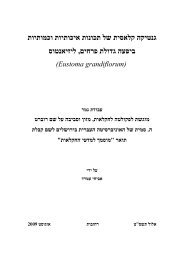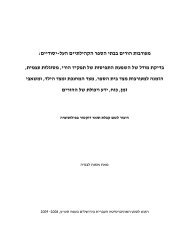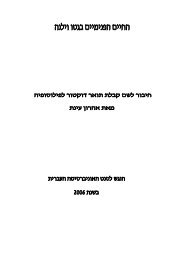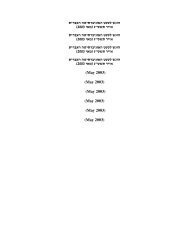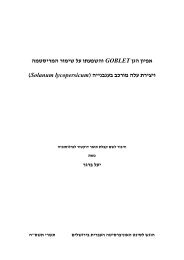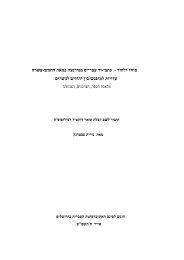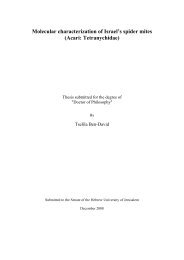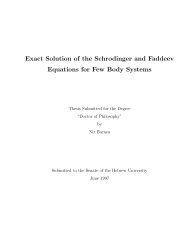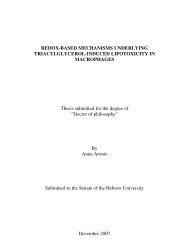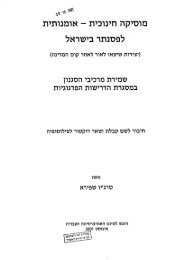Revealing the Mechanism of HSP104 Transcription Initiation in the ...
Revealing the Mechanism of HSP104 Transcription Initiation in the ...
Revealing the Mechanism of HSP104 Transcription Initiation in the ...
Create successful ePaper yourself
Turn your PDF publications into a flip-book with our unique Google optimized e-Paper software.
for <strong>the</strong>ir transcription, some 16% <strong>of</strong> <strong>the</strong> genes <strong>of</strong> S.cerevisiae do not need TAFs for<br />
<strong>the</strong>ir transcription (59, 71, 113). However, <strong>the</strong> majority <strong>of</strong> TAFs are essential for<br />
viability [reviewed <strong>in</strong> (48)], as are 10 <strong>of</strong> <strong>the</strong> twelve subunits <strong>of</strong> RNA PolII (23, 24).<br />
Follow<strong>in</strong>g b<strong>in</strong>d<strong>in</strong>g <strong>of</strong> TFIID, more prote<strong>in</strong> complexes are recruited to <strong>the</strong> promoter,<br />
i.e., <strong>the</strong> TFIIB complex, which assists RNA PolII <strong>in</strong> select<strong>in</strong>g <strong>the</strong> transcription start<br />
site. Then, <strong>the</strong> RNA PolII holoenzyme along with TFIIF, TFIIE, and TFIIH associate<br />
with <strong>the</strong> promoter and form <strong>the</strong> PIC. Follow<strong>in</strong>g establishment <strong>of</strong> PIC, promoter<br />
melt<strong>in</strong>g and transcription <strong>in</strong>itiation occur and are followed by hyperphoshorylation <strong>of</strong><br />
<strong>the</strong> C-term<strong>in</strong>al doma<strong>in</strong> (CTD) <strong>of</strong> <strong>the</strong> RNA polymerase through <strong>the</strong> TFIIH k<strong>in</strong>ase<br />
activity. This leads to promoter clearance and elongation <strong>of</strong> transcription [reviewed<br />
<strong>in</strong> (28)].<br />
All <strong>of</strong> <strong>the</strong> above events do not occur automatically s<strong>in</strong>ce <strong>in</strong>active promoters<br />
(such as promoters <strong>of</strong> heat shock genes <strong>in</strong> cells not exposed to stress) are not<br />
accessible to TBP and <strong>the</strong> subsequent complexes. Such promoters are part <strong>of</strong> DNA<br />
that is wrapped around histone prote<strong>in</strong>s (two H2A-H2B heterodimers and a H3-H4<br />
tetramer) which form nucleosomal structures. These nucleosomal structures are<br />
fur<strong>the</strong>r compacted <strong>in</strong>to tightly super-coiled structures called chromat<strong>in</strong>. Therefore,<br />
<strong>the</strong> b<strong>in</strong>d<strong>in</strong>g <strong>of</strong> <strong>the</strong> basal transcription mach<strong>in</strong>ery and <strong>the</strong> formation <strong>of</strong> PIC are<br />
h<strong>in</strong>dered by <strong>the</strong>se nucleosomes that have to be remodeled to enable transcription<br />
<strong>in</strong>itiation to occur. Thus, many preced<strong>in</strong>g steps should take place <strong>in</strong> order to allow <strong>the</strong><br />
formation <strong>of</strong> PIC and transcription <strong>in</strong>itiation. There is no general mechanism(s)<br />
lead<strong>in</strong>g to chromat<strong>in</strong> remodel<strong>in</strong>g and transcription <strong>in</strong>itiation <strong>of</strong> all genes and each<br />
promoter is activated <strong>in</strong> its own unique and specific way (2, 29, 42). Never<strong>the</strong>less, a<br />
general mechanism lead<strong>in</strong>g to gene activation is believed to be <strong>the</strong> follow<strong>in</strong>g. Upon<br />
an activat<strong>in</strong>g signal <strong>the</strong>re is b<strong>in</strong>d<strong>in</strong>g <strong>of</strong> prote<strong>in</strong>s known as transcriptional activators to<br />
enhancer elements (also called upstream activat<strong>in</strong>g sequences) <strong>in</strong> <strong>the</strong> relevant<br />
promoter and unb<strong>in</strong>d<strong>in</strong>g (where applicable) <strong>of</strong> transcriptional repressors. When<br />
bound to enhancers, transcriptional activators recruit chromat<strong>in</strong> modify<strong>in</strong>g complexes.<br />
The ma<strong>in</strong> purpose <strong>of</strong> <strong>the</strong>se chromat<strong>in</strong> modifications is to <strong>in</strong>duce “melt<strong>in</strong>g” <strong>of</strong><br />
nucleosomal structures <strong>in</strong> order to reduce <strong>the</strong> histone-DNA <strong>in</strong>teraction which enables<br />
<strong>the</strong> assembly <strong>of</strong> PIC. Chromat<strong>in</strong> modify<strong>in</strong>g complexes could be divided <strong>in</strong>to two<br />
general groups: i) Factors that, through <strong>the</strong> hydrolysis <strong>of</strong> ATP molecules, <strong>in</strong>duce<br />
conformational and spatial changes <strong>of</strong> nucleosomes (1, 43). ii) Factors that covalently<br />
modify histones by ei<strong>the</strong>r acetylation, phosphorylation, sumoylation, or methylation<br />
4



